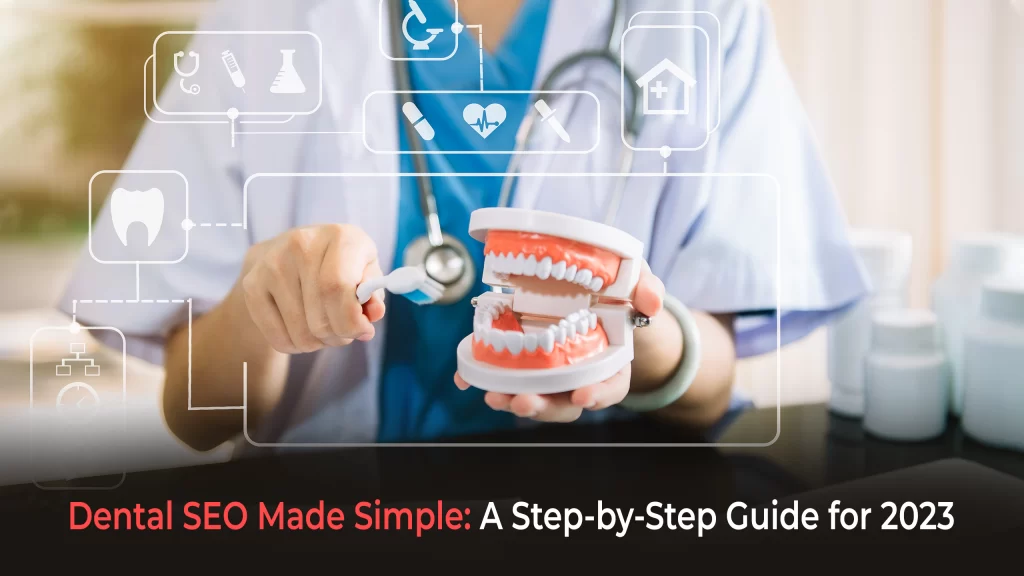In today’s digital age, having a strong online presence is essential for any dental practice looking to attract new patients and grow its business. One of the most effective ways to achieve this is through search engine optimization (SEO). By optimizing your dental practice’s website for search engines, you can increase your visibility in search results, drive more organic traffic to your site, and ultimately generate more leads and conversions. In this step-by-step guide, we will walk you through implementing dental SEO strategies for your practice in 2023.
Step 1: Keyword Research
The foundation of any successful SEO campaign is thorough keyword research. Start by identifying the keywords and phrases that potential patients are likely to use when searching for dental services in your area. In this case, our focus keyword is “Dental Marketing Services in USA,” but you should also consider related keywords like “Dental Marketing Services” and “Dental Marketing Agency.”
Utilize keyword research tools like Google Keyword Planner, SEMrush, or Ahrefs to discover relevant keywords with a high search volume and relatively low competition. Aim for a mix of broader keywords and long-tail keywords to capture a wide range of search queries.
Step 2: On-Page Optimization
Once you have identified your target keywords, it’s time to optimize your website’s on-page elements. This involves making strategic changes to your website’s content and structure to improve its visibility in search results.
Title tags: Include your target keywords in the title tags of your web pages. For example, “Dental Marketing Services in USA | Your Dental Practice Name.”
Meta descriptions: Craft compelling meta descriptions that accurately describe your services and entice users to click through to your site.
Header tags: Use header tags (H1, H2, etc.) to structure your content and include relevant keywords within these headings.
Content optimization: Create high-quality, informative, and engaging content that incorporates your target keywords naturally. Avoid keyword stuffing, as it can have a negative impact on your SEO efforts.
Step 3: Local SEO
As a dental practice catering predominantly to a local audience, prioritizing local SEO is paramount. Ensure your website is finely tuned for local searches by following these essential steps:
Google My Business: Take control of and enhance your Google My Business listing. Furnish precise and current details about your dental practice, encompassing your address, phone number, business hours, and captivating photos.
Local Directories: Boost your local SEO by ensuring your practice is prominently featured on well-regarded local directories such as Yelp, Yellow Pages, and Healthgrades. Maintaining a uniform NAP (Name, Address, Phone Number) across all platforms is vital to fortify your local online presence.
Online Reviews: Actively encourage content patients to share their positive experiences on platforms like Google, Yelp, and Facebook. Not only do reviews contribute to heightened local search rankings, but they also establish trust with potential patients, enhancing your credibility within the local community.
By focusing on these localized SEO strategies and leveraging expert local SEO services in Ahmedabad, your dental practice can establish a robust online presence, ensuring that you remain at the forefront when locals search for dental services in the area.
Step 4: Mobile Optimization
With the majority of internet searches now taking place on mobile devices, optimizing your website for mobile is crucial. Ensure your website is responsive, loads quickly, and provides a seamless user experience across different screen sizes.
Step 5: Link Building
Building high-quality backlinks to your website is an essential aspect of SEO. Seek opportunities to earn links from reputable dental websites, industry directories, local organizations, and dental associations. Guest blogging on relevant websites and participating in local events can also help you acquire valuable backlinks.
Step 6: Monitor and Analyze
Regularly monitor your website’s performance using tools like Google Analytics and Google Search Console. Track important metrics such as organic traffic, keyword rankings, and conversion rates. Analyze this data to identify areas for improvement and refine your SEO strategy accordingly.
Step 7: Stay Up to Date
SEO is an ever-evolving field, and it’s essential to stay updated with the latest trends and algorithm changes. Follow reputable SEO blogs, attend industry conferences, and keep an eye on Google’s official announcements to ensure your dental SEO strategy remains effective.
Conclusion
Implementing effective SEO strategies is crucial for dental practices to thrive in the competitive online landscape. By conducting thorough keyword research, optimizing your website’s on-page elements, focusing on local SEO, ensuring mobile optimization, building high-quality backlinks, and regularly monitoring your performance, you can significantly improve your dental practice’s visibility in search results and attract more patients. Stay proactive and adaptable in your approach to dental SEO, and you’ll reap the rewards of a strong online presence in 2023 and beyond.










